|
News and Events
Welcome to Windhoek, Namibia
May 1, 2006
We arrived in the Namibian capital today around 5:30pm. After what seemed
like a very long time at the car rental place, we drove about 1.25 hrs.
to our nights stay at the Eningu Clayhouse Lodge. But first, a note about Namibia’s roads.
During our research we read things like, “be sure to take plenty of
water and food in case you get stuck or have car problems,” and, “an extra
can of petrol is a good idea to carry with you as the petrol stations are
few and far between,” and, ”do not exceed 80 km/hr on gravel roads,” and,
“watch out for Kudu at night because they are particularly attracted to
lights and will charge your car.”
So reading these things in books and the travel guides from our travel
agency is one thing; driving these roads, especially at night with no working
mobile phone, with only 250ml of water and armed with only nail clippers
and my sharp wit is another story. Oh, we also have no clear idea of where we’re going.
We leave the airport on one of Namibia’s main national roads, the B6.
Immediately we became a little concerned that their major national road
is little more than a shoulder-less one-lane paved road with no street
lamps and very few signs. Our directions lead us to take the M51, a dirt
road, for 64 km. The dirt road goes on for forever. At any time I expect
to see a skull and crossbones sign that says, “You just left civilization.”
We are in the Wild West, or something akin to it. I saw a small impala
on the road, several owls, an overturned stagecoach, some animal carcasses
line the road, and I could have sworn that I also saw the remains of an
old-style mob lynching. When we arrived at our Lodge I felt like I should
order my drink in a dirty glass. It’s rural out here…
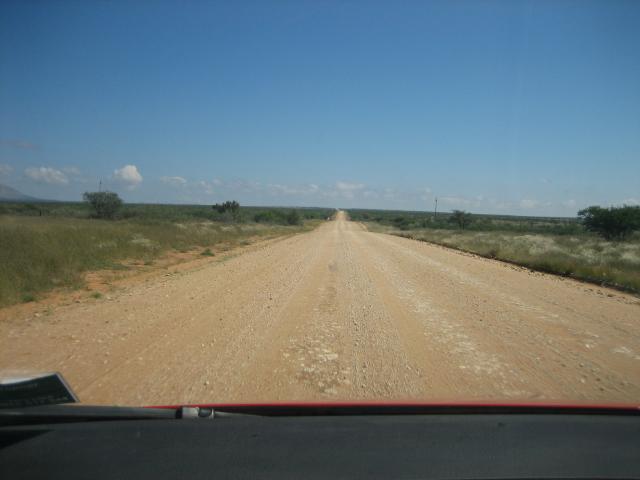
Our first night we stayed at the Eningu Clayhouse. We arrived just in
time for a late dinner of kudu steak and special truffles. The Clayhouse
is on the edge of the Kalahari savannah (the Kalahari isn’t a true desert
because they get too much rain. It’s classified as a savannah instead).
The cottages were made from handmade bricks from clay collected locally.
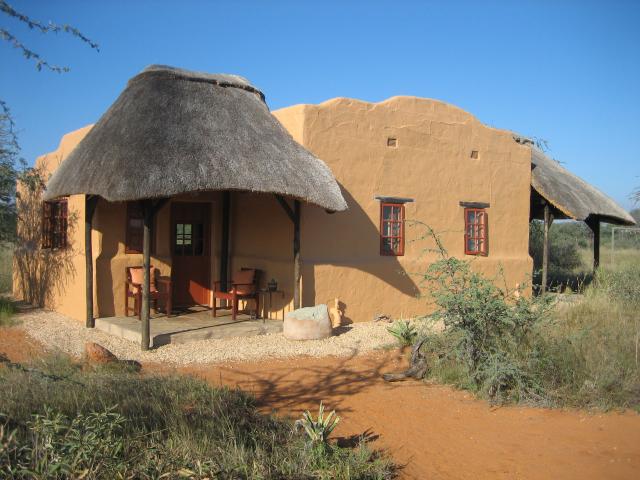
May 2, 2006
Sossusvlei Lodge
Leaving the Clayhouse we have to pass through Windhoek, the capital
of Namibia. It’s a normal small city, and we stock up on groceries and
I get a SIM card for the mobile phone. Within 15 minutes of our 5+ hr
journey from Windhoek to Sossusvlei, we run into a police roadblock.
We’re not carrying contraband so we’re not worried, unless noisy kids are contraband…
He asks for our driver’ license and we have both our NC license
and our International License, although both are in my backpack in
the back of the car. I tell him that and he recognizes our accent,
smiles and says, “God be with you in your travels.”
Now this gives me pause. What kind of country can you visit
that the police say, “God be with you in your travels?” It’s
almost a warning, a caution sign. I’d prefer him to say something
like, “Have a great time!” or, “Have fun, be careful.” But he
didn’t. He said, “God be with you.” Eerie, scary, prognostic
tingly. What does he know that we don’t? Weren’t we already
warned about the kudu and water and extra gas?...
This is a place that is NOT in the middle of Nowhere.
Nowhere came here, saw what was around, and left for some other geographic destination.
The Sossusvlei Lodge is in the middle of the Namibia Desert,
a cosmic void that takes 5+ hours from anywhere on the planet
to get here. It’s desolate. There are warning signs about 100
kilometers from the lodge warning you that there is no gas or
water for a long time. Unfortunately they don’t warn you that
no normal human being should ever be out in this area, much
less looking for gas or water. Myself, I’m looking for a
Barca-lounger with satellite TV and a six-pack of beer.
Unfortunately there are no signs to indicate that I am heading in the right direction for this.
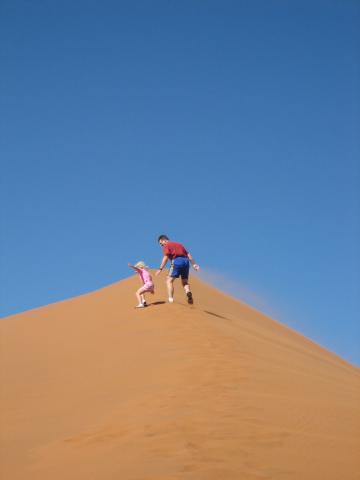
But it’s also beautiful here. The Namibia Desert catches the sun’s
rays and the shadows on the sand dunes are an unbelievable contrast.

May 3, 2006
This place is pretty cool, and we’re staying in a desert tent:
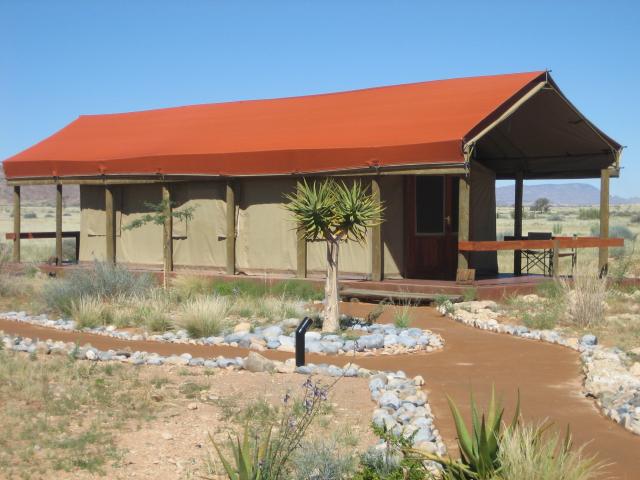
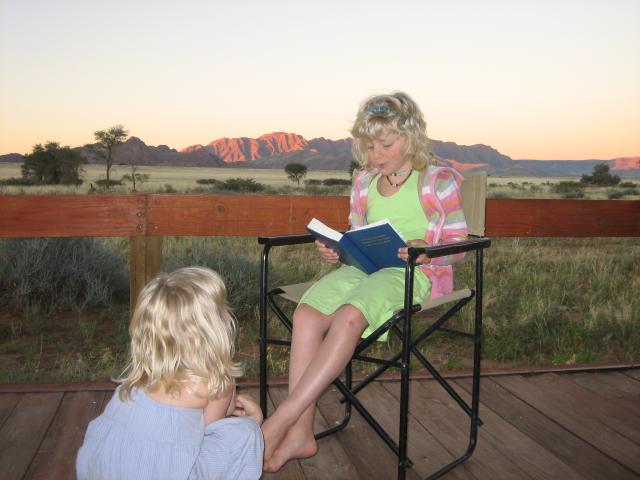
And they have the most unbelievable dinners on the planet, featuring
African game meat. Each night they have a buffet that you can sample African
game grilled over authentic Namibian braii:
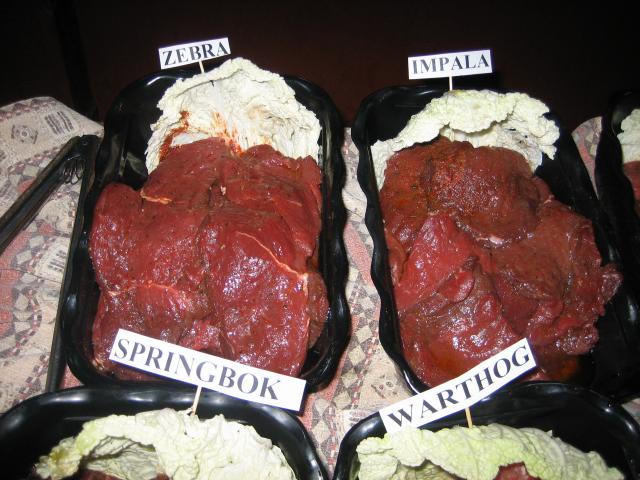

Having been born and raised on US-produced beef, chicken and pork,
these African meats are quite the exotic treat. In order to give you
an idea of the meat situation in Africa, it might be useful for me to
compare/contrast the qualities of African game meat to US beef. So for
your gastronomic pleasure, I give you the Rousseau US/African "Meat Comparison Charts" (Copywrite Pending):
| |
Meat |
Comments |
| 1 |
Beef Filet Mignon |
This is the king of soft meats. It would melt in your mouth if your mouth
were capable of melting flesh without the aid of teeth. |
| 2 |
Springbok |
Springbok was thinly sliced, which is not the greatest cut in testing the
tenderness of cuts. But it was very tender—almost to the point of singing sweet nothings to my gastro-intestinal track. |
| 3 |
Ostrich |
I ate ostrich several times; the most tender was marinated ostrich
(no surprise). For being so lean, it was surprisingly tender. |
| 4 |
Zebra |
Middle-range in tenderness. No other comments. |
| 5 |
Kudu |
The first time I tried Kudu it was tasty buy tough; the second time
was tasty and tender. Thus the middle-range ranking. |
| 6 |
Oryx |
Middle-range in tenderness. No other comments. |
| 7 |
Hartebeest |
Tough meat. If you look at a hartebeest face-on, you’ll understand what I’m saying. |
| 8 |
Crocodile |
This is a great mix between red and white meat. You only eat the tail,
and much of it is bone. The bones on the tail are cross-shaped which means
that you have to do a lot of cutting to get very little meat. |
Flavor, ranked in order of most flavorful too least flavorful:
| |
Meat |
Comments |
| 1 |
New York Strip Steak |
Can anything hold the smoky flavor of natural charcoal better? |
| 2 |
Springbok |
Again, we see Springbok in the #2 position… |
| 3 |
Ostrich |
Ostrich holds flavor well. We had braaied ostrich, marinated ostrich, and pan-fried ostrich. Ostrich is a solid meat. |
| 4 |
Kudu |
Flavorful meat. More flavor than tender. |
| 5 |
Crocodile |
Good flavor; good mix between red and white meat. |
| 6 |
Oryx |
Normal meat |
| 7 |
Hartebeest |
Normal meat |
| 8 |
Zebra |
Normal meat |
So, on the Rousseau Scale of Total Meat Pleasure (Copywrite Pending):
| Tenderness |
Filet Mignon |
| Flavor |
NY Strip Steak |
| Total Winner, flavor AND tenderness |
Springbok. A surprise? A great mix of both flavor and tenderness; the Tom Hanks of meat, if you will. |
Not only is this place a heaven for the gastronomic system, we also had a great time with the sand dunes.
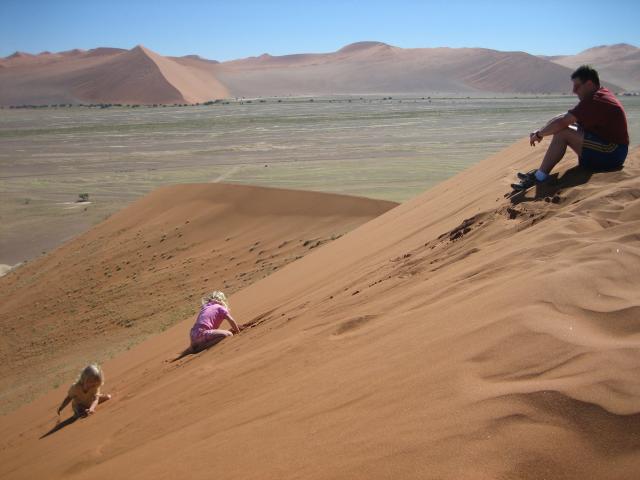
Sand Dunes Video
Note: if you can not see the video, download QuickTime and view the movie with it.

Dominique & Annette Sand Dune Video
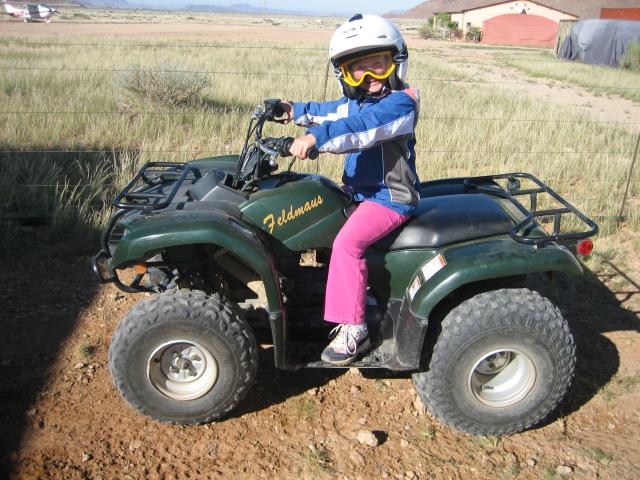
There’s a lot of sand here in the Namibia Desert. It was quite dry
and sandy. In fact, that’s the definition of desert: (paraphrased
from Webster’s Dictionary): “Desert: dez-ert; A lot of sand. A place
of very little rain. A very dry place usually designated with a lot
of sand. A place where you’d like to bring a lot of water and some
buckets and shovel with which to make sand castles because there is
nothing else to do. A place that Omar Sharif made a lot of movies that
featured a lot of sand in the form of dunes. Camels like it here. If
DRY was a person, DRY would live here.”
A bit of hyperbole here? I think not…
From here, we traveled to Swapokmund, about 5 hours away.
EVERYTHING in Namibia is about 5 hours away, on dirt roads,
with nothing in between. The dirt roads are empty, devoid of any
and all life. There is nothing between cities except 5 hours of
dirt road. Nothing. Here is an example of how much Nothing there
is on the 5-hour journey from Sossusvlei to Swapokmund:
Take a vacuum (which is void of any matter)
Double it
Multiply the result by minus infinity
Now add one
There’s so much nothing there that a black hole nearly
formed during our travels. That’s how much nothing there is along these Namibian roads.
May 4, 2006
May 5,6,7, 2006
Swapokmund, Namibia
Swapokmund is a German town. Established and settled by the
Germans after the world wars, you see signs for Brauhaus, Bierhaus,
and delis and serve brotchen and Auslese wine. We washed clothes,
visited a National Seal Colony, and saw some pretty cool architecture.
Much German is spoken here, and we got used to hearing, “Acht” all the
time. So we kinda picked it up for ourselves.
This is an incredible home to breeding seals. The breeding
colony of seals is the main attraction and we indulged ourselves with a self-guided drive.
The bull seals start arriving during October to demarcate their
territory and defend it aggressively. The pregnant cow seals arrive
later and give birth to a single pup within 1-2 days. About seven days
later, they come on heat again (Acht!) and mate with the nearest bull
(those hussies…). Then they return to the sea to feed for a few days,
leaving the pups to fend for themselves. At this time the pups are very
vulnerable to black-backed jackal, hyenas and the negative influence
of American Fox TV. When the cow seals return from the sea, they locate
their pup by a combination of scent and call and they then suckle them
for a few days. They then return to the sea to feed for a few days. This
cycle continues until the pups are weaned at 8 to 10 months old. Acht!
We arrived at the seal colony with the warning from our travel agent:
“Please note: Several thousand breeding seals are naturally going to create a
fair amount of smell (Acht!). If your sense of smell is particularly delicate, the
Cape Cross Seal colony may not be for you!”
What they should have said is this:
“ACHT! Think of the worst smell you have experienced and put a
number to it. Multiply that by 10, then square that result, then
add a googol (1 with 100 zeros behind it, sometimes called a duotrigintillion).
This number will be a good approximation of about half of what the smell will be like”
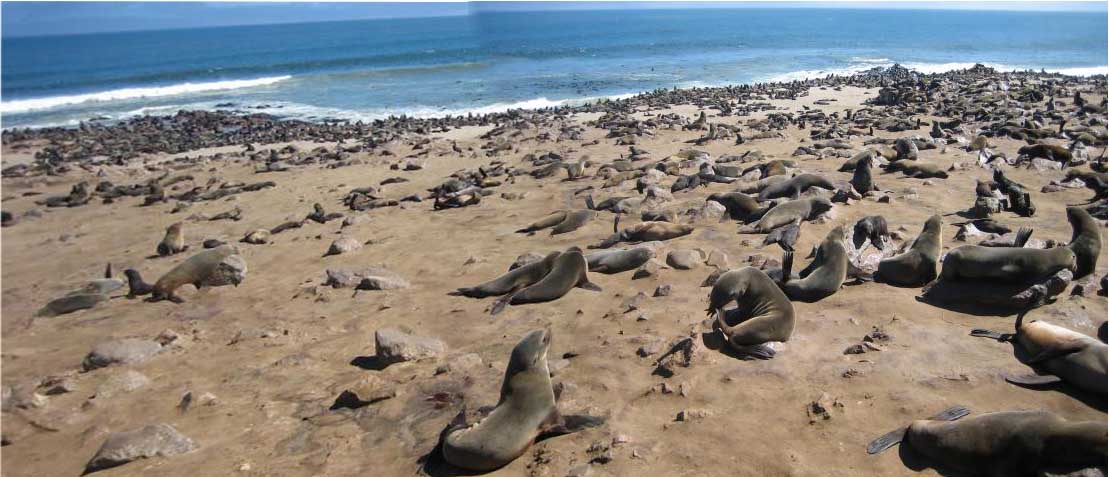
Stinky Seals Video
So besides being a German village (Acht!) and having really cool architecture
(they have really cool architecture here), we really didn’t do much except relax and spend time on the beach.
May 7,8,9,10, 2006
Rustig Toko Lodge, Kaokoveld area, Damaraland region. I think that you have
to name just about everything here with 3+ syllables.
This is a wonderful lodge in the middle of Damaraland,
uh…, Kaokoveld, uh… it’s pretty much in the middle of nowhere. Acht. But it was extremely
comfortable and gave us great food.
The most interesting thing we did during our three-day stay here was a
morning visit to the Himba people. These are the real deal live in a mud
hut; wipe yourself with a leaf people.
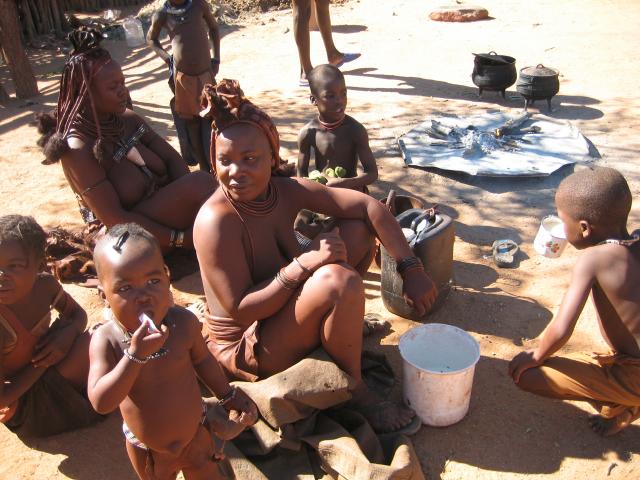
The Himba People
Himba Village Video (7 min.)
Video notes:
The young woman that’s shaking the gourd is making the rancid butterfat.
They drink this and also use it to create the red paste (see below)
There is a part of the video where you see a bunch of kids stomping around
in mud. This is actually a bunch of kids stomping around in mud and cow dung.
Mixed with water, they create a clay that they spread onto their huts. The smell is quite interesting…
The Caucasian lady in the video assists the Himba in adapting to 21st
century living. Her father owns the land on which the Himba live, and her
brother is a linguist that lives with this Himba tribe on a full time basis.
So when you think of Africa, you think of people that live in mud huts,
wear loincloths, and wipe themselves with leaves. We met these people.
No indoor plumbing, no cable TV. No TV at all, no electricity, no running
water. No soap, no formal schooling, no utensils. No chairs either, much to my booty’s chagrin.
We spent the morning with these wonderful people. As soon as we entered
their village they raised their arms to the kids in an attempt to hold them.
With no form of birth control, you have to know that they love children…
The Himba are famous for coating their skin with a red-ochre and rancid
butterfat mixture that protects them from the harsh sun and acts as a bug
repellant. This cream gives their bodies a very reddish glow, which is a
Himba trait of beauty, as is their intricate hairstyles.
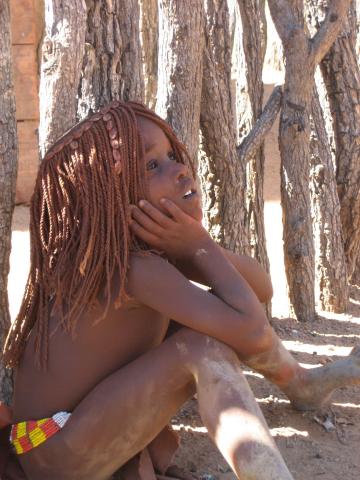
The Himba are herdsmen, breeding mainly cattle and goats while leading a
semi-nomadic life. They migrate with their herds to the different waterholes
from season to season. The Himba children have “chores” according to their
ages—the very young must watch over the livestock; the older females must
help with the maintenance of food and shelter; the teenage males seem to
want to be teenage males, as the ones we saw were all wearing modern Western
clothing (aka. baggy pants/shorts with shirts that would fit Paul Bunyan).
For the Himba, clothes, hair and jewelry hold a special meaning and form
an important part of their tradition and culture. Even newborn babies are
adorned with pearl necklaces while older children are given bracelets crafted
from copper and decorated with shells. They are differentiated by the style
of jewelry they wear—triangle shapes designate the females;
non-triangles are the males.
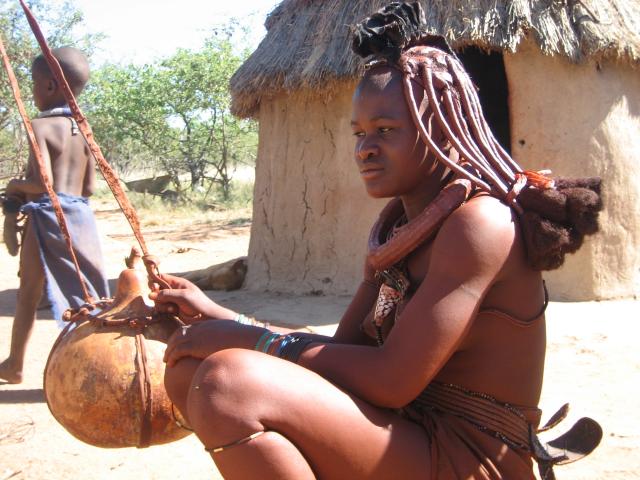
Having no running water they clean themselves by making a small smoking
pot, wrapping a long cloth around their shoulders, and they sit on top of
the smoking pot for 5-45 minutes. Talk about someone blowing smoke up your butt…
The Himba live in dome-shaped huts made from a shell of wood that’s
covered with a clay made from palm leaves, mud and cattle dung. We were
fortunate to see the mud and cattle dung mixture being made (see video
above) and the smell was exactly what you’d expect it to be when you’re
stomping through several hundred pounds of poop.
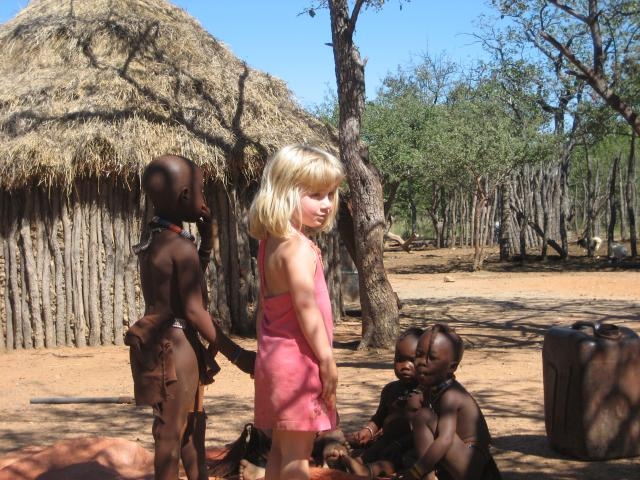
The kids were so friendly with Dominique and Annette. They played
ball with them, showed them around the huts, and held their hands as they were walking around.
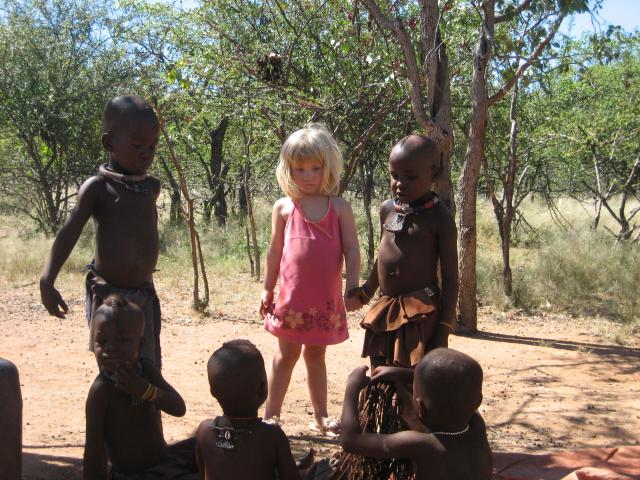
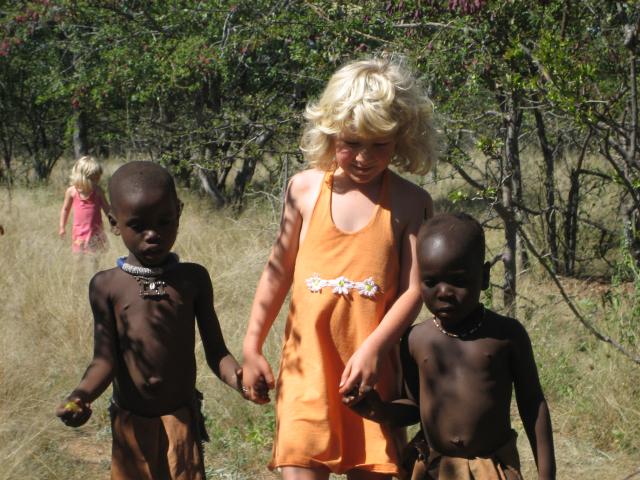
|